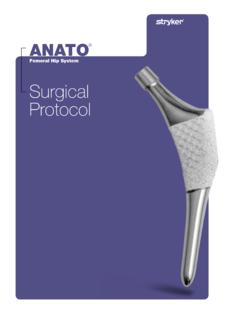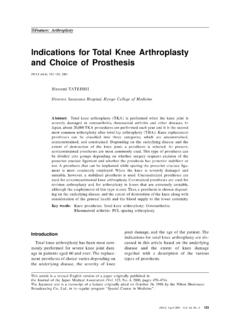Transcription of Tria thlon PKR Pa rtial Knee Resu rfacing Surgical Protocol
1 Triathlon PKRP artial knee ResurfacingSurgical ProtocolTable of ContentsAcknowledgments ..4 Introduction ..4 Procedural Summary/Highlights ..5 Tibial Preparation ..8 Excision of Osteophytes ..8 Assembling the Ankle Clamp ..9 Attaching the Ankle Clamp ..10 Flexion/Extension Alignment (Tibial Slope) ..11 Varus/Valgus Adjustment ..11 Tibial Resection Level ..12 Sagittal Resection and Rotational Alignment ..13 Transverse Tibial Resection ..13 Before Removing the Tibial Resection Guide ..13 Femoral Preparation ..15 Distal Resection ..15 Alignment Check ..16 Posterior and Chamfer Resections.
2 17 Sizing and Trialing ..19 Tibial Sizing ..19 Femoral Trialing ..20 Trial Reduction ..21 Femoral Peg Preparation ..21 Tibial Peg Preparation ..22 Cementation ..23 Tibial Cementation ..23 Femoral Cementation ..23 Tibial Insert ..24 Alternate Femoral Preparation ..25 Triathlon PKRS urgical ProtocolAcknowledgmentsSpecial thanks to all those surgeons involved in the design and development of theTriathlon PKR Partial knee Resurfacing is a fixed bearing unicompartmental knee thatblends the ease of a measured resection system with the control of a ligamenttension restoring gap balancing system.
3 The single radius design of the TriathlonPKR implant is designed to produce more stable, natural knee motion by couplingthe ability to restore ligament tension and balance flexion and extension gaps.>The femoral implant has a single radius from 10 of flexion through 110 offlexion and is equally 7mm thin posteriorly and distally. This design allows forgap balancing in only a few simple steps.>The Triathlon PKR balances flexion and extension gaps by varying the distalresection. In the Triathlon PKR System the posterior resection remains a fixed7mm, while the distal resection is varied to accommodate degenerative changesof the PKRS urgical Protocol45 Procedural Summary/Highlights1 Tibial Resection2 Assess Flexion Gap3 Assess Extension Gap4 Verify Alignment5 Distal Resection6 Posterior/ChamferResection7 Trialing8 Final Preparation9 CementationTriathlon PKRS urgical Protocol6 IndicationsThe Triathlon PKR components are for use inunicompartmental knee arthroplasty as a result of.
4 Moderately disabling joint disease of the kneeresulting from painful osteo- or post traumaticarthritis. Revision of previous unsuccessful surgicalprocedures, either involving, or not involving,previous use of a unicompartmental kneeprosthesis. As an alternative to tibial osteotomy in patientswith unicompartmental osteoarthritis. Where bone stock is of poor quality or inadequatefor other reconstructive techniques as indicatedby deficiencies of the femoral components are intended for implantationwith bone include: Patient has an active or suspected latent infectionin or about the knee joint.
5 Patient has a known sensitivity to devicematerials. Patient s bone stock is compromised by diseaseand/or infection, or prior implantation whichcannot provide adequate support and/or fixationcannot be provided to the prosthesis. Patients with inflammatory arthritis. Patients with major deformity affecting themechanical axis of the knee or neuromusculardisorders compromising motor control and/orstability. Any mental neuromuscular disorder, which wouldcreate an unacceptable risk of prosthesisinstability, prosthesis fixation failure orcomplications in post-operative care.
6 Skeletal immaturity. Ligamentous instability such that the post-operative stability afforded by theunicompartmental knee prosthesis would becompromised such as multidirectional/ACLinstability. Untreated damage to the contralateralcompartment or the ipsilateral knee not beingreplaced by a prosthesis. Untreated deterioration or destruction of thepatello-femoral joint. Severe deformity and/or recurrent subluxation ofthe knee joint. Obesity. An overweight or obese patient canproduce loads on the prosthesis, which can lead tofailure of fixation of the device or failure of thedevice itself.
7 Severe tibial bone loss/deformity (over 15 degreesvarus).* See package insert for warnings, precautions,adverse effects and other essential calProcedure7 TibialPreparationFigure 1 Figure 2 Figure 38 Excision of Osteophytes>Before beginning bone preparation of the affectedcompartment, there are several areas of the jointthat should be inspected for osteophytes. Allosteophytes must be removed before proceeding tothe rest of the procedure. These areas include butare not limited to the:>Margin of the femoral condyle.>Margins of the intercondylar PKRS urgical ProtocolTibial PreparationTriathlon PKR System utilizes a tibia first approachto the unicompartmental arthroplasty .
8 Accuratealignment of instrumentation to anatomical referencesduring the tibial resection step of this procedure willaid in establishing tibial/femoral component all femoral resections are instrumented byreferencing the tibial resection, care should be takenduring the preparation of the tibial 4 Figure 5>Beneath the medial collateral ligament. >Additional preparation of the affected compartmentmay also include the removal of the the Ankle ClampFigure 6 Figure 7 Figure 8 Attaching the Ankle Clamp>The fixation arm of the Proximal Rod is fullyextended to reach the tibial eminence.
9 Pin the headof the Proximal Rod into an exposed area of theanterior proximal tibia, generally located anterior tothe ACL insertion point. 10 Triathlon PKRS urgical ProtocolNote:Fully extending the fixation arm prior toattaching it to the Tibial eminence will help allow forclearance of the Tibial Resection Guide. Once theheadless pin has been placed, the Tibial resection guidemay be advanced toward the tibia. >Move the leg to 70 of flexion (flexion past 70 mayresult in tightening of the quadriceps muscle andmake soft tissue retraction difficult).>Attach the Ankle Clamp assembly to the ankle andposition the distal tube of the assembly along thelong access of the tibia.
10 >Rotate the entire assembly to ensure that the base ofthe assembly is aligned with the center of the center of the ankle is generally in line with thesecond metatarsal or medial 1/3rd of the 9 Figure 10 Flexion/Extension Alignment (Tibial Slope)>Flexion/Extension alignment is correct when thelong axis of the Ankle Clamp/Proximal RodAssembly parallels the mid-coronal plane of thetibia. This scenario will provide 0 of :The slope of the Tibial Resection Guide is 0 degrees. There is no slope built into the tibialcomponents of the Triathlon PKR system.>Additional slope can be introduced to the guide bypulling the distal end of the Ankle Clamp Assemblyaway from the Adjustment>Varus/Valgus Alignment can be changed byloosening the adjustment knob on the Ankle ClampAssembly and by sliding the assemblymedially/laterally.

















